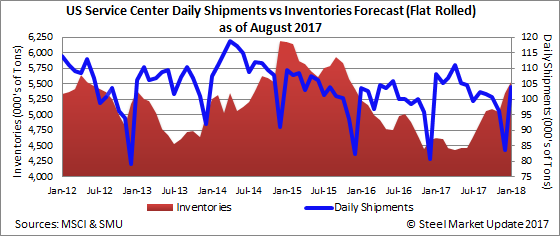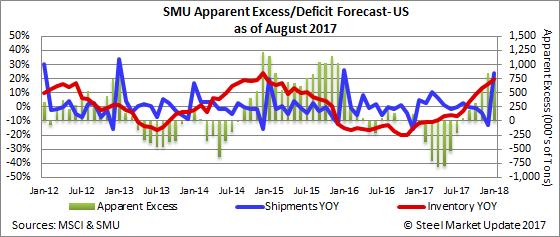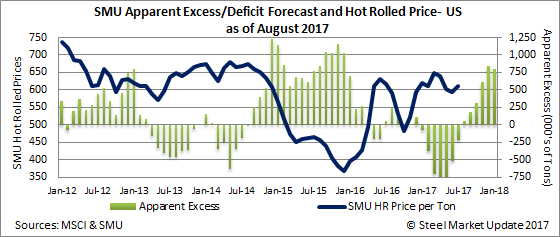SMU Data and Models

Distributors Flat Rolled Deficit to be Eliminated by End of August
Written by John Packard
August 18, 2017
The Steel Market Update (SMU) Service Center Inventories Apparent Excess/Deficit forecast provided last month showed that the deficit in inventories being held by flat rolled distributors would shrink. We have worked with the MSCI carbon flat rolled shipment and inventory data and our model indicates the deficit did indeed shrink and is very close to our forecast.
The MSCI reported carbon flat rolled shipments at 1,991,000 tons. This is 20,000 tons more than our forecast of 1,971,000 tons.
Inventories at the U.S. flat rolled service centers ended the month of July at 4,646,000 tons, which was slightly higher than our forecast of 4,589,000 tons.
Using our model, we show the distributors as having shrunk the inventory deficit from -525,000 tons down to -218,000 tons. The SMU forecast was for the deficit to shrink to -232,000 tons.

August Forecast
Steel Market Update is forecasting flat rolled shipments out of the U.S. service centers to be 2,352,000 tons for the month of August. Our forecast is based on the average monthly change for August over the past four years. In this case, the average change was +2.7 percent.
We are also forecasting that the flat rolled steel distributors will hold 4,862,000 tons of inventory at the end of the month.

If our shipment and inventory forecasts are correct, the service centers will have eliminated their inventory deficit and will be in a “balanced” position with +50,000 tons.
Looking at the months to come using the same formula, we then expect September through January to see a jump in inventories and, in the process, a jump in the amount of excess steel that will be on the distributors’ floors every month through January.


John Packard
Read more from John PackardLatest in SMU Data and Models

SMU Scrap Survey: Sentiment Indices rise
Both current and future scrap sentiment jumped this month, though survey participants reported responses before key trade news was announced.

SMU Survey: Sentiment splits, buyers have better view of future than the present
SMU’s Steel Buyers’ Sentiment Indices moved in opposite directions this week. After rebounding from a near five-year low in late June, Current Sentiment slipped again. At the same time, Future Sentiment climbed to a four-month high. Both indices continue to show optimism among buyers about their company’s chances for success, but suggest there is less confidence in that optimism than earlier in the year.

SMU scrap market survey results now available
SMU’s ferrous scrap market survey results are now available on our website to all premium members. After logging in at steelmarketupdate.com, visit the pricing and analysis tab and look under the “survey results” section for “ferrous scrap survey” results. Past scrap survey results are also available under that selection. If you need help accessing the survey results […]

SMU flat-rolled market survey results now available
SMU’s latest steel buyers market survey results are now available on our website to all premium members. After logging in at steelmarketupdate.com, visit the pricing and analysis tab and look under the “survey results” section for “latest survey results.” Past survey results are also available under that selection. If you need help accessing the survey results, or if […]

SMU Survey: Sheet lead times stabilize, plate contracts
Mill lead times for sheet products were steady to slightly longer this week compared to our late June market check, while plate lead times contracted, according to steel buyers responding to this week’s market survey.
